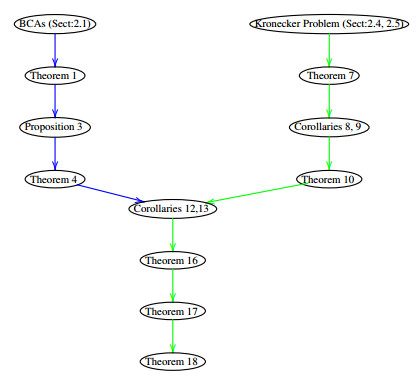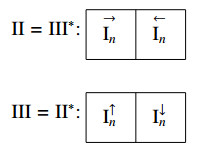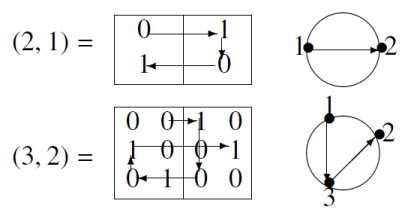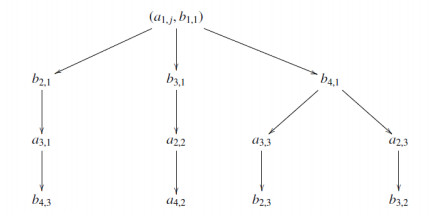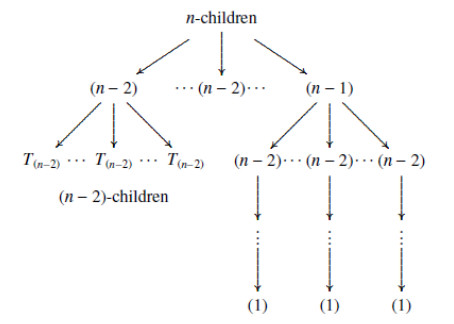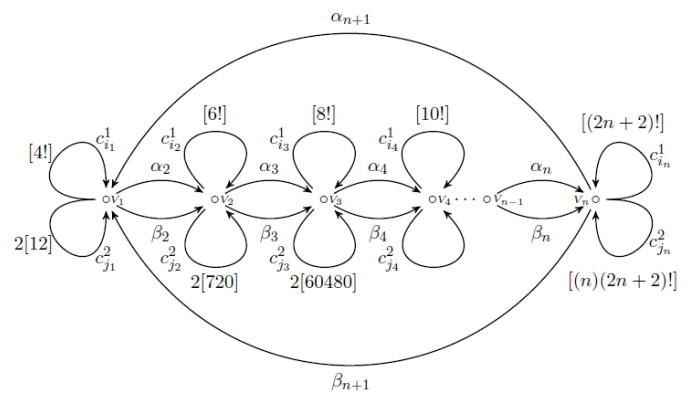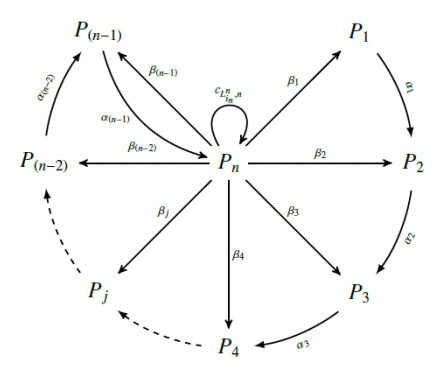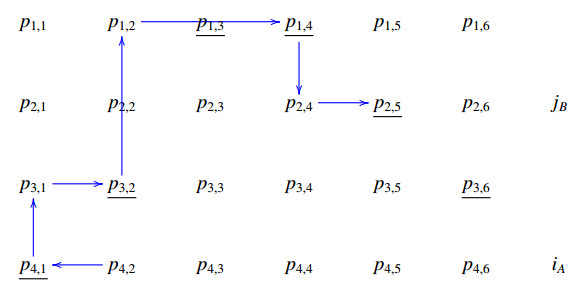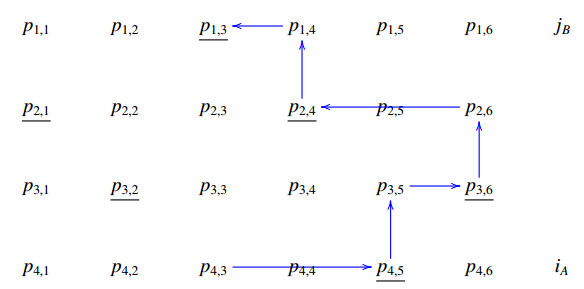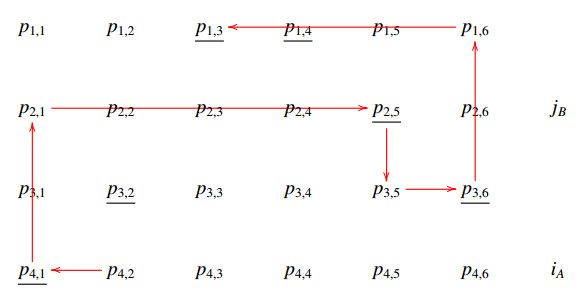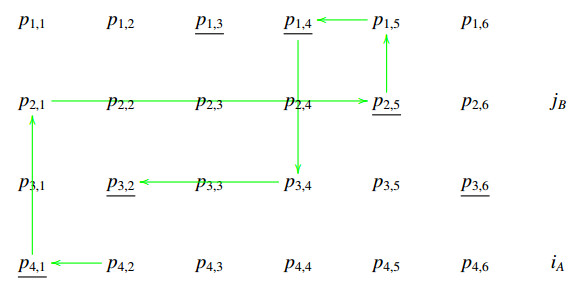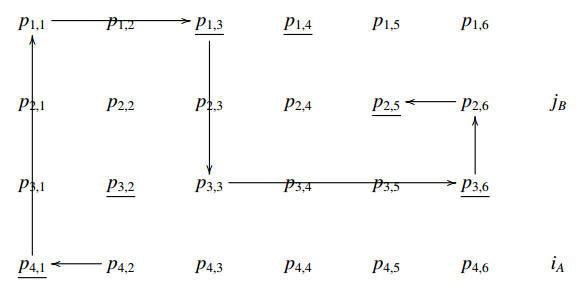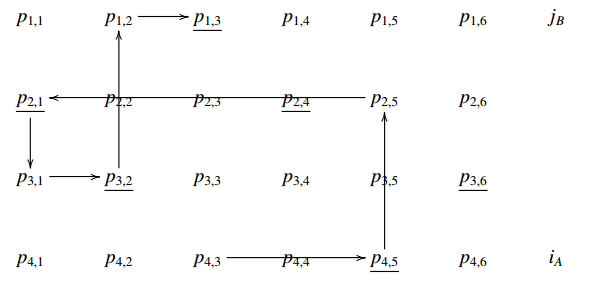1.
Introduction
According to Ringel and Fahr [1], a categorification of a sequence of numbers means to consider instead of these numbers suitable objects in a category (for instance, representation of quivers) so that the numbers in question occur as invariants of the objects, equality of numbers may be visualized by isomorphisms of objects functional relations by functorial ties. The notion of this kind of categorification arose from the use of suitable arrays of numbers to obtain integer partitions of dimensions of indecomposable preprojective modules over the 3-Kronecker algebra (see Figure 1, where it is shown the 3-Kronecker quiver and a part of its associated oriented 3-regular tree or universal covering (T,E,Ωt) as described by Ringel and Fahr in [2]).
Firstly they noted that the vector dimension of these kinds of modules consists of even-index Fibonacci numbers (denoted fi and such that fi=fi−1+fi−2, for i≥2, f0=0, f1=1) then they used results from the universal covering theory developed by Gabriel and his students to identify such Fibonacci numbers with dimensions of representations of the corresponding universal covering. In particular, preinjective and preprojective representations of the 3-Kronecker quiver were used in [2] by Ringel and Fahr to derive a partition formula for even-index Fibonacci numbers.
The categorification process of even-index Fibonacci numbers introduced in [2] allowed Ringel and Fahr to define an array of numbers T=T(i,j) called even-index Fibonacci partition triangle [3] with similar properties as the Pascal\textquotesingle s triangle and to include the integer sequence A132262 in the OEIS (On-Line Encyclopedia of Integer Sequences). In particular, some modules called Fibonacci modules, Auslander-Reiten sequences and suitable filtrations of these types of modules were used in [1] to categorify the following identities between Fibonacci numbers:
Entries in the array T are categorified by Fibonacci modules provided that they give Jordan-Hölder multiplicities of these modules.
We point out that Ringel in [4] exhibits combinatorial data which can be derived from a category modΛ, where Λ is a hereditary {Artin} algebra of Dynkin type Δ. He comments that many enumeration problems give rise to categorification of different integer sequences. For instance, the number of some tilting modules and the number of antichains in modΛ categorify the Catalan numbers if Λ is an algebra of Dynkin type An. Whereas, if Λ is of Dynkin type Bn then such number of modules and antichains categorify the sequence (2nn). Results regarding the categorification of integer sequences encouraged Ringel to propose the creation of an On-Line Encyclopedia of Dynkin Functions (OEDF) with the same purposes as the OEIS. Such construction is currently an open problem (the number of indecomposable Λ-modules over an algebra Λ of Dynkin type is an example of a Dynkin function).
1.1. Contributions
In this work, to categorify integer sequences, we identify combinatorial information arising from the preprojective component of the 2-Kronecker algebra (or simply the Kronecker algebra) with combinatorial information arising from indecomposable projective modules over some Brauer configuration algebras introduced recently by Green and Schroll in [5]. In particular, we use these settings to define categorifications of the sequences encoded in the OEIS as A052558 and A052591. Configurations of some multisets called polygons define such Brauer configuration algebras.
We recall here that the Kronecker problem is equivalent to the problem of determining the indecomposable representations over a field k of the 2-Kronecker quiver Q illustrated in Figure 2.
We will see that some invariants associated with indecomposable projective modules over some suitable Brauer configuration algebras allow categorify any counting function. Since polygons in Brauer configurations are multisets, we will assume that such polygons consists of words of the form
where for each i, 1≤i≤t, xi is an element of the polygon called vertex and si is the number of times that the vertex xi occurs in the polygon. In particular, if vertices xi in a polygon V of a Brauer configuration are integer numbers then the corresponding word w will be interpreted as a partition of an integer number nV associated with the polygon V where it is assumed that each vertex xi is a part of the partition and si is the number of times that the part xi occurs in the partition and nV=t∑i=1sixi.
The following diagram (1.3) shows how the theory of Brauer configuration algebras (BCAs) and the Kronecker problem are related to the main results (targets of green arrows) presented in this paper.
This paper is distributed as follows: in Section 2, we recall main definitions and notation used throughout the document, in particular, in this section we define Brauer configuration algebras, and the Kronecker problem.
In Section 3, some directed graphs named helices are associated with preprojective Kronecker modules to categorify numbers in sequences A052558 and A052591. Besides, it is defined a sequence ΛKn of Brauer configuration algebras whose indecomposable projective modules are in bijective correspondence with preprojective Kronecker modules via the number of summands in the heart of such indecomposable modules. Formulas for the dimension of this type of algebras and corresponding centers are also given. Section 4 describes how it is possible to use integer sequences to build Brauer configuration algebras, the process is applied to any counting function. Concluding remarks are given in Section 5. Examples of helices are shown in the Appendix.
2.
Preliminaries
In this section, we recall main definitions and notation to be used throughout the paper [5,6,7,8,9,10].
2.1. Brauer configuration algebras
Green and Schroll introduced in [5] Brauer configuration algebras as a generalization of Brauer graph algebras which are biserial algebras of tame representation type and whose representation theory is encoded by some combinatorial data based on graphs. According to them, underlying every Brauer graph algebra is a finite graph with a cyclic orientation of the edges at every vertex and a multiplicity function [6]. The construction of a Brauer graph algebra is a special case of the construction of a Brauer configuration algebra in the sense that every Brauer graph is a Brauer configuration with the restriction that every polygon is a set with two vertices. In the sequel, we remind Brauer configuration and Brauer configuration algebra definitions.
A Brauer configuration Γ is a quadruple of the form Γ=(Γ0,Γ1,μ,O) where:
(B1) Γ0 is a finite set whose elements are called vertices.
(B2) Γ1 is a finite collection of multisets called polygons. In this case, if V∈Γ1 then the elements of V are vertices possibly with repetitions, occ(α,V) denotes the frequency of the vertex α in the polygon V and the valency of α denoted val(α) is defined in such a way that:
(B3) μ is an integer valued function such that μ:Γ0→N where N denotes the set of positive integers, it is called the multiplicity function.
(B4) O denotes an orientation defined on Γ1 which is a choice, for each vertex α∈Γ0, of a cyclic ordering of the polygons in which α occurs as a vertex, including repetitions, we denote Sα such collection of polygons. More specifically, if Sα={V(α1)1,V(α2)2,…,V(αt)t} is the collection of polygons where the vertex α occurs with αi=occ(α,Vi) and V(αi)i meaning that Sα has αi copies of Vi then an orientation O is obtained by endowing a linear order < to Sα and adding a relation Vt<V1, if V1=minSα and Vt=maxSα, the set (Sα,<) is called the successor sequence at the vertex α. According to this order the αi copies of Vi can be ordered as V1,i<V2,i<⋯<V(αi−1),i<Vαi,i and Sα can be ordered in the form V(α1)1<V(α2)2<⋯<V(α(t−1))(t−1)<Vαtt. It is worth noting that this ordering is kept without changes in the successor sequences containing all the polygons V1,V2,…,Vt,
(B5) Every vertex in Γ0 is a vertex in at least one polygon in Γ1.
(B6) Every polygon has at least two vertices.
(B7) Every polygon in Γ1 has at least one vertex α such that μ(α)val(α)>1.
A vertex α∈Γ0 is said to be truncated if val(α)μ(α)=1, that is, α is truncated if it occurs exactly once in exactly one V∈Γ1 and μ(α)=1. A vertex is nontruncated if it is not truncated.
2.2. The quiver of a Brauer configuration algebra
The quiver QΓ=((QΓ)0,(QΓ)1) of a Brauer configuration algebra is defined in such a way that the vertex set (QΓ)0={v1,v2,…,vm} of QΓ is in correspondence with the set of polygons {V1,V2,…,Vm} in Γ1, noting that there is one vertex in (QΓ)0 for every polygon in Γ1.
Arrows in QΓ are defined by the successor sequences. That is, there is an arrow visi⟶vi+1∈(QΓ)1 provided that Vi<Vi+1 in (Sα,<)∪{Vt<V1} for some nontruncated vertex α∈Γ0. In other words, for each nontruncated vertex α∈Γ0 and each successor V′ of V at α, there is an arrow from v to v′ in QΓ where v and v′ are the vertices in QΓ associated with the polygons V and V′ in Γ1, respectively.
2.3. The ideal of relations and definition of a Brauer configuration algebra
Fix a polygon V∈Γ1 and suppose that occ(α,V)=t≥1 then there are t indices i1,…,it such that V=Vij. Then the special α-cycles at v are the cycles Ci1,Ci2,…,Cit where v is the vertex in the quiver of QΓ associated with the polygon V. If α occurs only once in V and μ(α)=1 then there is only one special α-cycle at v.
Let k be a field and Γ a Brauer configuration. The Brauer configuration algebra associated with Γ is defined to be the bound quiver algebra ΛΓ=kQΓ/IΓ, where QΓ is the quiver associated with Γ and IΓ is the ideal in kQΓ generated by the following set of relations ρΓ of type I, II and III.
1) Relations of type I. For each polygon V={α1,…,αm}∈Γ1 and each pair of nontruncated vertices αi and αj in V, the set of relations ρΓ contains all relations of the form Cμ(αi)−C′μ(αj) where C is a special αi-cycle and C′ is a special αj-cycle.
2) Relations of type II. Relations of type II are all paths of the form Cμ(α)a where C is a special α-cycle and a is the first arrow in C.
3) Relations of type III. These relations are quadratic monomial relations of the form ab in kQΓ where ab is not a subpath of any special cycle unless a=b and a is a loop associated with a vertex of valency 1 and μ(α)>1.
Henceforth, if there is no confusion, we will assume notations, Λ, I and ρ instead of ΛΓ, IΓ and ρΓ for a Brauer configuration algebra, the ideal and set of relations, respectively defined by a given Brauer configuration Γ.
The following results give some description of the structure of Brauer configuration algebras [5,7].
Theorem 1 ([5], Theorem B, Proposition 2.7, Theorem 3.10, Corollary 3.12). Let Λ be a Brauer configuration algebra with Brauer configuration Γ.
1) There is a bijective correspondence between the set of indecomposable projective Λ-modules and the polygons in Γ.
2) If P is an indecomposable projective Λ-module corresponding to a polygon V in Γ. Then radP is a sum of r indecomposable uniserial modules, where r is the number of (nontruncated) vertices of V and where the intersection of any two of the uniserial modules is a simple Λ-module.
3) A Brauer configuration algebra is a multiserial algebra.
4) The number of summands in the heart ht(P)=radP/socP of an indecomposable projective Λ-module P such that rad2P≠0 equals the number of nontruncated vertices of the polygons in Γ corresponding to P counting repetitions.
5) If Λ′ is a Brauer configuration algebra obtained from Λ by removing a truncated vertex of a polygon in Γ1 with d≥3 vertices then Λ is isomorphic to Λ′.
Proposition 2 ([5], Proposition 3.3). Let Λ be the Brauer configuration algebra associated with the Brauer configuration Γ. For each V∈Γ1 choose a nontruncated vertex α and exactly one special α-cycle CV at V,
Then A∪B is a k-basis of Λ.
Proposition 3 ([5], Proposition 3.13). Let Λ be a Brauer configuration algebra associated with the Brauer configuration Γ and let C={C1,…,Ct} be a full set of equivalence class representatives of special cycles. Assume that for i=1,…,t, Ci is a special αi-cycle where αi is a nontruncated vertex in Γ. Then
where |Q0| denotes the number of vertices of Q, |Ci| denotes the number of arrows in the αi-cycle Ci and ni=μ(αi).
The following result regards the center of a Brauer configuration algebra.
Theorem 4 ([7], Theorem 4.9). Let Γ be a reduced and connected Brauer configuration and let Q be its induced quiver and let Λ be the induced Brauer configuration algebra such that rad2Λ≠0 then the dimension of the center of Λ denoted dimkZ(Λ) is given by the formula:
where |CΓ|={α∈Γ0∣val(α)=1,andμ(α)>1}.
2.4. The Kronecker problem
The classification of indecomposable Kronecker modules was solved by Weierstrass in 1867 for some particular cases and by Kronecker in 1890 for the complex number field case. This problem is equivalent to the problem of finding canonical Jordan form of pairs of matrices (A,B) (with the same size) with respect to the following elementary transformations over a field k (for the sake of brevity, it is assumed that k is an algebraically closed field):
(i) All elementary transformations on rows of the block matrix (A,B).
(ii) All elementary transformations made simultaneously on columns of A and B having the same index number.
If the matrix blocks P=(A,B) and P′=(A′,B′) can be transformed one into the other by means of elementary transformations, then they are said to be equivalent or isomorphic as Kronecker modules. Figure 3 shows the matrix form (up to isomorphism) of the non-regular Kronecker modules [8,9]:
In this case, →In (←In, respectively) denotes an n×(n+1) matrix obtained from the identity In by adding a column of zeroes. In fact, the last column (the first column, respectively) in these matrices consists only of zeroes. Similarly, I↑n (I↓n) denotes an n+1×n matrix obtained from an n×n identity matrix by adding at the top (at the bottom) a row of zeroes.
We recall that the solution of the Kronecker matrix problem allows classifying the indecomposable representations of the path algebra kQ with Q a quiver with the shape given in Figure 2.
Figure 4 shows the preprojective component of the Auslander-Reiten quiver of the 2-Kronecker quiver which has as vertices isomorphism classes of indecomposable representations of type III ([i+1i] is a notation for the dimension vector of a preprojective representation (equivalently, preprojective module), whereas [mm+1] is the dimension vector of a preinjective module). The preinjective component has isomorphism classes of indecomposable representations of type III∗ as vertices.
Henceforth, we let (n+1,n) ((n,n+1)) denote a representative of an isomorphism class of preprojective (preinjective) Kronecker modules obtained from a representation of type III (II) via elementary transformations. Actually, for the sake of simplicity, we will assume that such representatives have the form III (II).
2.5. Helices
For n≥1, let P be an (n+1)×2n, k-matrix then P can be partitioned into two (n+1)×n matrix blocks A and B. In such a case we write P=(P,A,B,n), where A=(ai,j)=[CAi1,…,CAin], B=(bi,j)=[CBj1,…,CBjn], with CAir (CBjs) columns of P, if IA (IB) is the set of indices IA={ir∣1≤r≤n} (IB={js∣1≤s≤n}) then IA∩IB=∅, and |IA|=|IB|=n. In this case, each column of the matrix P belongs either to the matrix A or to the matrix B and a word WP=lm1…lmn…lm2n, lmh∈{A,B}, 1≤h≤2n is used to denote matrix P by specifying the way that columns of P have been assigned to the matrices A and B.
A row rP of P has the form (rA,rB) with rA (rB) being a row of the matrix block A (B). We let RA (RB) denote the set of rows of the matrix block A (B), whereas Hn denotes the set of all matrices P with the aforementioned properties.
An helix associated with a matrix P of type Hn is a connected directed graph h whose construction goes as follows:
(h1) (Vertices) Vertices of h are entries of blocks A and B. We let h0 denote the set of vertices of h.
(h2) Fix two different rows iP=(iA,iB) and jP=(jA,jB) of P.
(h3) Choose sets PA and PB of pivoting entries also called pivoting vertices, PA⊂A, PB⊂B such that |PA|=|PB|=n. Entries in A∖PA and B∖PB are said to be exterior entries or exterior vertices. In this case, if x∈PA (x∈PB) then x∉iA (x∉jB).
PA and PB are sets of the form:
where, air,jr∈RA∖iA, btm,hm∈RB∖jB, 1≤r,m≤s. It is chosen just only one entry air,jr (btm,hm) for each row in RA∖iA (RB∖jB) and for each column CA (CB) of A (B).
(h4) (Arrows) arrows in h are defined in the following fashion:
(a) Arrows in h are either horizontal or vertical. We let h1 denote the set of arrows of h.
(b) Horizontal arrows connect a vertex of the matrix block A (B) with a vertex of the matrix block B (A). Vertical arrows only connect vertices in the same matrix block. Starting and ending vertices of horizontal (vertical) arrows are entries of the same row (column) of P.
(c) The starting vertex of a horizontal (vertical) arrow is an exterior (pivoting) vertex. The ending point of a horizontal (vertical) arrow is a pivoting (exterior) vertex.
(d) A pivoting vertex occurs as ending (starting) vertex just once. Thus, h does not cross itself.
(e) The first and last arrow of h are horizontal and its starting vertex belongs to iA.
(f) Each vertical arrow is preceded by a unique horizontal arrow, and unless the first arrow, any horizontal arrow is preceded by a vertical arrow.
(g) All the rows of P are visited by h, and no row or column of P is visited by arrows of h more than once.
(h) There are not horizontal arrows connecting exterior vertices of jA with vertices of jB.
Remark 5. We let (iP,jP,PA,PB) denote the set of all helices which can be built by fixing these data associated with a matrix P of type Hn, hPn=|(iP,jP,PA,PB)| denotes the corresponding cardinality. See diagrams (A1)–(A8) in the Appendix where it is presented a set (4P,2P,PA,PB) defined by the word BAABAB.
Matrix presentations of preprojective Kronecker modules p of type III are of type Hn, n≥1 (In this case, Wp=AA…ABB…B). In [10], the authors studied sets of helices (1p,(n+1)p,pA={ai+1,i∣1≤i≤n},pB={bi,i∣1≤i≤n}) associated with this kind of matrices.
Proposition 6. If WP is the set of matrix words associated with a matrix P of type Hn then |WP| equals n2∑m=0P(n,n,m)=(n+1)Cn, where P(n,n,m) denotes the number of partitions of m into n parts, each ≤n, P(n,n,0)=1, and Cn denotes the nth Catalan number.
Proof. Each matrix word WP of the form WP=lm1…lmn…lm2n, lmh∈{A,B}, 1≤h≤2n, gives rise to an integer partition λ=(λ1,λ2,…,λt), λi,t≤n of a nonnegative integer number m≤n2 by defining λ1 as the number of A's after the first occurrence of the letter B, λ2 is the number of A′s after the second occurrence of the letter B and so on. Since there are n letters A′s and n letters B′s in WP then the number of words associated with P is (2nn). The result holds.
In Theorem 10 we prove that the number of helices hpn associated with a preprojective Kronecker module, p=(n+1,n) is hpn=n!⌈n2⌉.
If we associate with a set of n equidistant points on a circle the rows of a representation p=(n+1,n) then the number of helices containing the fixed arrow a1,1→b1,1 equals the number a(n) of ways of connecting n+1 equally spaced points on a circle with a path of n line segments ignoring reflections. In this case, vertical edges in a helix are in bijective correspondence with the edges of the path in the circle (Figure 5 shows examples of helices and these kinds of paths). Thus
Sequence a(n) is recorded as A052558 in the OEIS.
3.
Categorification of the sequences A052558 and A052591
Results in this section can be interpreted as categorifications (see Remark 2) of the sequences (n−1)!⌈n2⌉ and n!⌈n2⌉ (A052558 and A052591 in the OEIS, respectively) via Kronecker modules and Brauer configuration algebras. Theorems 7 and 10 and Corollaries 8 and 9 prove that the number of helices associated with preprojective Kronecker modules is invariant with respect to admissible transformations.
The following results regard the number of helices associated with matrices of type Hn and in particular with preprojective Kronecker modules (see Figure 4), k is an algebraically closed field.
Theorem 7. Let (P,A,B,n), (P′,A′,B′,n), HP and HP′ be two matrices of type Hn with corresponding sets of helices HP and HP′ defined by systems of the form (iP,jP,PA,PB) and (fP′,gP′,P′A′,P′B′), respectively. Then |HP|=hPn=|HP′|=hP′n.
Proof. Firstly, we suppose without loss of generality that, iP≠fP′ and jP≠gP′. Then, we note that each helix h∈(iP,jP,PA,PB) gives rise to a unique helix h′∈(iP,gP,PA″,PB″), where PA″ and PB″ are suitable sets of pivoting entries in P. The process consists of copying helix h, in such a way that each occurrence of entries of jP is substituted by a corresponding occurrence of gP (taking into account the new sets of pivoting vertices, PA″ and PB″), conversely, each occurrence of gP is substituted by a corresponding occurrence of jP, keeping without changes the remaining rows visited by the helix h. For example, if a vertical arrow v∈h1 connects entries pi,j (starting vertex) and pi′,j (ending vertex) in P then the corresponding vertical arrow v′∈h′1 connects entries of the rows i and i′ if i∈{jP,gP} and i′∉{jP,gP} or if i and i′ are such that i,i′∉{jP,gP}, v′ connects rows i and j (g) if i′=g (i′=j). We let σ denote the bijection, σ:(iP,jP,PA,PB)→(iP,gP,PA″,PB″) defined by these substitutions. Thus, if a bijection δ:(iP,gP,PA″,PB″)→(fP,gP,PA′,PB′) is defined as σ where PA′ and PB′ are sets of pivoting entries of P given by P′A′ and P′B′ respectively, then the maps composition δσ is also a bijection from (iP,jP,PA,PB) to (fP,gP,PA′,PB′). Any helix h′∈(fP,gP,PA′,PB′) corresponds uniquely to an helix h″∈(fP′,gP′,P′A′,P′B′) via the identification τ:P→P′ such that τ(pi,j)=p′i,j, in this case pi,j∈PA′ (pi,j∈PB′) if and only if p′i,j∈P′A′ (p′i,j∈P′B′). In general, a copy h″∈(fP′,gP′,P′A′,P′B′) of an helix h′∈(fP,gP,PA,PB) can be built taking into account that an initial exterior vertex ef,j∈h′ has a vertex e′f,j′∈fA′ as its corresponding initial exterior copy and h″ visits the same rows in the same order as those visited previously by h′. We are done.
Examples of copies of elements of the set
associated with a matrix P of type H3 and defined by the word WP=BAABAB are given in the Appendix (see A1–A8). In such a case, the corresponding copies belong to the set
and the matrix P is partitioned according to the word ABABBA.
Corollary 8. Let WP=lm1…lm2n and W′P=l′m1…l′m2n; lmn,l′mn∈{A,B} be two words associated with a matrix P of type Hn with corresponding sets of helices HP=(iP,jP,PA,PB), and H′P=(f′P,g′P,P′A,P′B). Then |HP|=|H′P|.
Proof. The result follows from Theorem 7 by replacing, P′,A′,B′,P′A′,P′B′,fP′ and gP′ for P,A,B,P′A,P′B,f′P and g′P, respectively.
Corollary 9. If for n≥1, P and P′ are equivalent preprojective Kronecker modules with dimension vector of the form [n+1n] and corresponding sets of helices HP and HP′ then |HP|=|HP′|.
Proof. Matrix presentations of preprojective Kronecker modules P and P′ are both of type Hn defined by words of the form AA…ABB…BB.
Theorem 10. If for n≥1, P denotes a preprojective Kronecker module then the number of helices associated with P is hPn=n!⌈n2⌉ where ⌈x⌉ denotes the smallest integer greatest than x.
Proof. According to Theorem 7 and Corollary 9, it suffices to determine the number of helices |(1p,(n+1)p,pA={ai+1,i∣1≤i≤n},pB={bi,i∣1≤i≤n})| associated with preprojective Kronecker modules p=(n+1,n) of type III and words of the form Wp=AA…ABB…B.
Firstly, we note that there is only one helix associated with the indecomposable preprojective modules (2,1) and (3,2). And the vertices sequence of helices associated with the indecomposable (4,3) with a1,j fixed are:
The number of helices is given by the number of vertices at the last level of the rooted tree showed in Figure 6:
Suppose now that the result is true for any indecomposable preprojective Kronecker module (t+1,t), 1≤t<n then we can see that in general the rooted tree Tn associated with the indecomposable preprojective Kronecker module (n+1,n) has the following characteristics bearing in mind that vertex b1,1 gives the root node a01:
(a)a01 has n children enumerated from the left to the right as (a11,a12,…,a1n),
(b) For 1≤i≤n−1 each vertex a1i has n−2 children enumerated from the left to the right as (a1i,1,a1i,2,…,a1i,n−2) whereas vertex a1n has n−1 children of the form (a1n,1,a1n,2,…,a1n,n−1), each children of a vertex a1n,l1, 1≤l1≤n−1 has n−2 children a1n,l1,l2 with 1≤l2≤n−2, in general for this particular tree a vertex a1n,l1,l2,l3,…,lt has n−(t+1) children, 1≤t≤n−2. Note that the number of vertices at the last level of the rooted tree T′n with a1n as root node is (n−1)!,
(c) For each h, 1≤h≤n−2, vertex a1i,h is a root node of the tree Tn−2.
Figure 7 shows the general structure of the rooted tree Tn.
According to the rules (a)−(c) the number of vertices LTn at the last level of the tree Tn is given by the formula
We are done.
Remark 11. Sequence A052558 is categorified via the number of helices associated with preprojective Kronecker modules, if in the condition (e) of its definition, it is assumed that the starting vertex is fixed. Without such fixing condition the number of helices associated with a preprojective Kronecker module is given by the sequence encoded as A052591 in the OEIS.
3.1. Sequence A052591 Via Brauer configuration algebras
In this section, categorification of elements of the integer sequence A052591 is given via the number of summands in the heart of indecomposable projective modules over the Brauer configuration algebra ΛKn defined by the Brauer configuration Kn=(Kn0,Kn1,μ,O) with the following properties for n≥3 fixed:
1)
2) The orientation O is defined in such a way that for t≥1
3) The multiplicity function μ is such that μ(x1)=μ(x2)=1.
where the symbol x(j)i in a given polygon Vt means that occ(xi,Vt)=j. Note that, the specializations x1=1 and x2=2 allows describing polygons Vt as integer partitions of numbers in the sequence A052591 (see Eq (1.2)).
Figure 8 shows the Brauer quiver QKn associated with this configuration (numbers nt1(nt2) attached to the loops denote the occurrence of the vertex (x1 above, x2 below) in the corresponding polygon Vt, 1≤t≤n), c1it(c2jt) denotes a set of loops associated with the vertex Vt, |c1it|=l1t=nt1−1, |c2jt|=l2t=nt2−1.
The admissible ideal I is generated by the following relations (in this case, if there are associated l1t (l2t) loops at the vertex Vt associated with x1 (associated with x2) then we let Pjt denote the product of j≤lmt loops, m∈{1,2}), cmhs is a notation for a set of cycles {cmhs,1,cmhs,2,…,cmhs,lms,m∈{1,2},h∈{i,j},s∈{1,2,…,n}}:
1) c1is,xc1is,y−c1is,yc1is,x, for all possible values of i,s,x,y,
2) c2js,xc2js,y−c2js,yc2js,x, for all possible values of i,s,x,y,
3) c1is,xc2js,y and c2js,xc1is,y, for all possible values of i,s,x,y,
4) c1is,xβs+1; c2js,yαs+1; βsc1is,x; αsc2js,x, for all possible values of i,s,x,y,
5) (c1is,x)2; (c2js,y)2, for all possible values of i,s,x,y,
6) αtαt+1; αn+1α2; βtβt+1; βn+1β2;αtβt+1; βjαj+1; αn+1β2; βn+1α2, for all possible values of j,t,
7) αiPjiγi+1; αn+1Pj1γ2; βtPhtγt+1; βn+1Ph1γ2; 0<j<l1i, 0<h<l2t, 1≤i,t≤n, γ∈{α,β},
8) For all the possible products (special cycles) of the form:
relations of the form εri−εsj, r,s∈{1,2,3,4}, i,j∈{1,2} take place. Note that, products of the form P0t−1 correspond to suitable orthogonal primitive idempotents et, 1≤t≤n,
9) ε11αt, ε32βt.
The following result holds for indecomposable projective modules over the algebra ΛKn.
Corollary 12. For n≥3 fixed and 1≤t≤n, the number of summands in the heart of the indecomposable projective representation Vt over the Brauer configuration algebra ΛKn equals the number of helices associated with the preprojective Kronecker module (2t+3,2t+2), 1≤t≤n.
Proof. Firstly we note that for any t, rad2Vt≠0. Thus according to the Theorem 1 the number of summands in the heart of any of the indecomposable projective modules Vt equals occ(x1,Vt)+occ(x2,Vt)=(2t+2)!+t(2t+2)!=hp2t+2=h(2t+3,2t+2)2t+2 which is the number of helices associated in a unique form to the indecomposable preprojective Kronecker module (2t+3,2t+2). We are done.
The following results regard the dimension of algebras of type ΛKn.
Corollary 13. For n≥3 fixed, it holds that 12(dimkΛKn)=n+tγn−1+tδn−1, where γn=n∑m=1m(2m+2)!, δn=n∑m=1(2m+2)!, and th denotes the hth triangular number.
Proof. Proposition 3 allows concluding that dimkΛKn/I=2n+2∑i=1|Ci|(|Ci|−1) where for each i=1,2, |Ci|=val(xi). The theorem holds taking into account that for any j≥2, j(j−1)=2tj−1.
Corollary 14. For n≥3 fixed, it holds that dimkZ(ΛKn)=−n+1+n∑t=1hp2t+2.
Proof. Since rad2ΛKn≠0, the result is a consequence of Theorem 4 with μ(x1)=μ(x2)=1, |Kn0|=2, |Kn1|=n and occ(x1,Vt)+occ(x2,Vt)=hp2t+2.
Remark 15. Similar results as those given in Corollaries 12-14 can be obtained for preprojective Kronecker modules of the form (4t+2,4t+1),t≥1 by considering in the original Brauer configuration that
keeping the relations in the quiver without changes (bearing in mind of course the new occurrences of the vertices for the different products). In particular, it holds that dimkZ(ΛKn)=−n+1+n∑t=1hp4t+1.
4.
Brauer configuration algebras arising from counting Functions
In this section, we consider Brauer configurations arising from counting functions which are strictly increasing integer sequence whose elements count a given class of objects Dn. For instance, Dn can be the set of linear extensions of a poset (Pn,⊴)={(i,j)∈N2∣0≤i≤j≤n}, where ⊴ is a partial order defined on Pn such that (i,j)⊴(i′,j′) if and only if i≤i′ and j≤j′. According to Stanley [11], the number of linear extensions e(Pn) of Pn is equal to the number of lattice paths from (0,0) to (n,n) with steps (1,0) and (0,1), which never rise above the main diagonal x=y of the plane (x,y)-plane. It can be shown that e(Pn) is given by the nth Catalan number Cn=1n+1(2nn).
We define now a family of Brauer configuration algebras ΛDn, n>1 arisen from Brauer configurations Dn whose nontruncated vertices are in correspondence with objects of type Dn, polygons are obtained by choosing objects of type Ds, for 1≤s≤n. We assume the notation Lsj,n∈Ds for the jth object of type s in a given polygon. Without loss of generality, we assume that for the first polygon P1, it holds that |P1|=u1>1.
For n≥2 fixed, the definition of the Brauer configuration
goes as follows:
In Ph(h−1), it holds that, 1≤i1≤u1 if s=1, and 1≤is≤us−u(s−1), if s>2.
The orientation On is defined by the usual order of natural numbers. Thus, for a vertex Lij,n∈Dn0∖Pnn, the successor sequence has the form
For vertices L(n−1)r,n, the successor sequence has the form P(n−1)<Pn, whereas for vertices of the form Lnr,n∈Pnn, the orientation is of the form Pn<Pn.
The following Figure 9 shows the shape of the Brauer quiver QDn defined by Dn.
αj, βj and cLnin,n denote j×1-matrices of the form:
where αjLsis,n (βjLsis,n) is a set of arrows defined by the successor sequence at vertex Lsis,n connecting the corresponding polygons (polygon Pn with the corresponding Pj). And cLnin,n is a set of loops defined by vertices Lnin,n, 1≤in≤un−u(n−1).
The following relations generate the admissible ideal J of the Brauer configuration algebra ΛDn=kQDn/J, for all possible values of i,i′,j,j′,r,r′ and n.
1) (cLnr,n)2, cLnr,ncLnr′,n, r≠r′,
2) αjLir,nαjLi′r′,n, i≠i′,
3) αjLir,nα(j+1)Li′r′,n,
4) cLnin,nβi,
5) α(n−1)cLnin,n,
6) For 1≤j≤n, fixed and 1≤i≤j, sLij,n−sLjj′,n where sx is a special cycle associated with the vertex x,
7) βiαi,
products of the form; βiαi, α(n−1)cLnin,n, cLnin,nβi means that relations of the form xx′, y′y and z′z take place where x′, y′ and z′ are entries of the corresponding matrices.
The following result categorifies numbers of a counting function ut, for t≥1.
Theorem 16. For 1≤i≤n and n>1 fixed, the number of summands in the heart of the indecomposable projective module Pi over the algebra ΛDn is ui.
Proof. Since rad2Pi≠0, then the number of summands in the heart of the indecomposable projective module Pi equals the number of its nontruncated vertices counting repetitions, which by definition is given by the sum u1+(u2−u1)+⋯+(u(i−1)−u(i−2))+(ui−u(i−1))=ui. We are done.
Theorem 17. For n≥1 fixed, dimkΛDn=2n+n(n−1)u1+2n∑i=2t(n−i)(ui−u(i−1)).
Proof. It suffices to note that val(Liis,n)=n−i+1 and μn(Liis,n)=1 for any Liis,n∈Dn0∖Pnn, whereas for any x∈Pnn, it holds that val(x)=1 and μn(x)=2. We are done.
Since for any n>1, rad2ΛDn≠0, then we have the following result regarding the center of these algebras.
Theorem 18. For n≥2 fixed, dimkZ(ΛDn)=(un−u(n−1))+(n+1).
Proof. Note that |Dn0|=un, |Dn1|=n, ∑α∈Dn0μn(α)=2un−u(n−1). Since #(LoopsQD(n−1))=|CDn|, the theorem holds.
Remark 19. Perhaps, the sequence Cn of Catalan numbers is one of the most interesting counting functions, they count the number of plane binary trees with n+1 endpoints (or 2n+1 vertices), the number of triangulations of an (n+3) polygon, or the number of paths L in the (x,y)-plane from (0,0) to (2n,0) with steps (1,1) and (1,−1) that never pass below the x-axis, such paths are called Dyck paths [11]. Thus, if un=Cn+1, n≥1 then Theorem 4.1 categorifies numbers in this sequence Cn via these enumeration problems.
Since the number of compositions (partitions in which the order of the summands is considered) of a positive integer n in which no 1's appear is the Fibonacci number f(n−1) [12]. Then Theorem 4.1 categorifies these numbers by assuming that un=f(n−1) with n≥4. If j>4, then dimk(Z(ΛDj)/Cj)−1=f(j−4), where Cj is a k-subspace of Z(ΛDj) isomorphic to Z(ΛDj−1).
Theorem 16 categorifies the sequence p(n) which gives the number of partitions of a positive integer n, recall the Hardy-Ramanujan theorem which states that for large n, p(n)∼14n√3eπ√2n3 (see also the sequence A002865 whose numbers give the differences p(n)−p(n−1)). In this case, we use un=p(n+1), n≥1.
Another interesting sequence categorified by Theorem 4.1 is the sequence M(n) encoded in the OEIS as A000372, which consists of Dedekind numbers, these numbers count the number of antichains in the powerset 2n (i.e., the set consisting of all the subsets of n={1,2,3,…,n}) ordered by inclusion or the number of elements in a free distributive lattice on n generators. In this case un=M(n), for n≥1, worth noting that up to date only 8 numbers of this sequence are known.
5.
Concluding remarks
Any counting function (e.g., Fibonacci numbers, Catalan numbers, or Dedekind numbers) can be categorified in the sense of Ringel and Fahr via indecomposable projective modules over some Brauer configuration algebras. In particular, integer sequences encoded in the OEIS as A052558 and A052591 are categorified by preprojective Kronecker modules via some helices, which are suitable directed graphs associated with these modules.
Acknowledgments
This research has been supported by the Seminar Alexander Zavadskij on Representation of Algebras and Its Applications at Universidad Nacional de Colombia.
Conflict of interest
The authors declare there are no conflicts of interest.
Appendix
In this section, we present the set of helices
associated with a matrix P of type H3 and defined by the word WP=BAABAB. The corresponding copies (see Theorem 7) in
are also shown according with the associated word ABABBA.
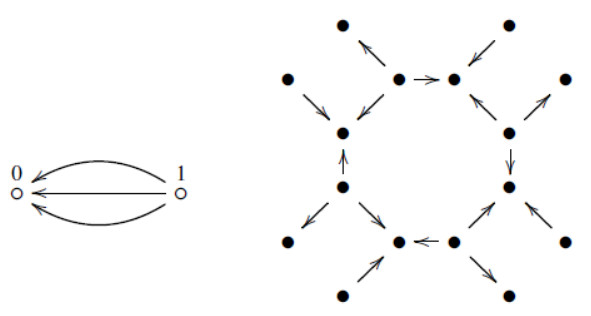









 DownLoad:
DownLoad:

